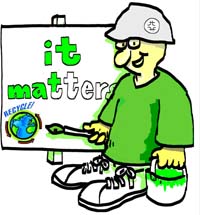Fermilab community embraces recycling program
 |
| Seymour Green (above) is Fermilab's recycling mascot. |
Fermilab's latest recycling venture looks set to continue the tradition of award-winning environmentalism.
In its first year involving a majority of the laboratory site, the glass, plastic and metal recycling program has increased steadily.
From January to October, the amount of recycled material in the program rose from 2,000 to 5,000 pounds a month. Although by weight that is less than the 250,000 pounds of paper and card board or the more than 200,000 pounds of electronic recyclables collected annually, it amounts to a significant portion of the less common glass, plastic and metal waste. As the program ages and grows, officials expect to have a better handle on the percentage of waste diverted from landfills.
"I think the lab has done a really good job," said Eric Mieland, Fermilab's recycling coordinator. "Where this type of recycling is available, it has been embraced. People were ready to do it. People are willing to do it."
The program started two years ago in the Village and was expanded this year to encompass 80 percent of the laboratory. Next year, officials plan to include the remaining 20 percent, which is scattered throughout the site in buildings with more diverse waste issues.
The program encompasses recycling from office cubicles, work buildings, Village housing and recreation areas. The program encompasses all the non-paper items that you would recycle at home through your municipal curbside recycling.
Fermilab launched the program as part of its good-neighbor efforts rather than to save money. It costs the laboratory about as much to collect and recycle the material as it would to dispose of it as non-recyclable trash. But the program has an added nonmonetary benefit, Mieland said.
"We are diverting the material from the landfill," he added. "We are being good stewards of the environment."
Officials hope to see the same success with the battery recycling program started last year. A report on that program will become available next November.
-- Tona Kunz
|